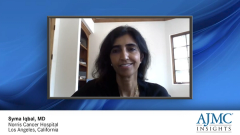
Immunotherapy Considerations for Upper GI and Esophageal Cancer Treatment Pathways
Key opinion leaders emphasize the significant role of immunotherapy for patients being treated for gastroesophageal cancer.
James M. Cleary, MD, PhD: Increasingly, hospitals—including mine—have pathways that tell us what the recommended treatments are for our patients at a certain course in their illness. At my hospital, we have to enter it in and show that we’re using the pathways. If we aren’t using the pathways, [we have to] give a justification for why we aren’t. This has been a good thing. I’m always incredibly impressed by community oncologists who have to take care of everything. They have to be up to date with breast cancer, lymphoma, leukemia, and gastroesophageal cancer. I don’t know how they do it. By having pathways, it helps people [keep] up with research and know what the experts in the field are recommending. For oncology in general, having these pathways has been a great advantage.
Laura Bobolts, PharmD, BCOP: Pathways may be employed at times with patients with upper GI [gastrointestinal] and esophageal cancers. Why is that? Because there are so many options in the market. A pathway is selecting a subset of treatment regimens, typically based on national guidelines such as NCCN [National Comprehensive Cancer Network], but you’re going a level deeper. You aren’t looking at only the efficacy. You’re also looking at the toxicity and the total cost of care, including resource utilizations. Is this patient more likely to need more supportive care medications on this regimen vs another?
A pathway selects a subset of regimens to reduce variation in care, align therapy with evidence-based medicine, and provide a metric to measure oncologists for high-quality, cost-effective cancer care. But we must also keep in mind that there are unique patients. Not every patient fits into a pathway bubble, but pathways fit into the treatment of these cancers. If you look at the NCCN, in the first-line setting of esophageal and GEJ [gastroesophageal junction] cancers, there are 18 options bulleted. The options may vary based on biomarkers, but there are 18 options to consider. When you look at gastric cancer, NCCN bullets 14 options in the first-line setting. That isn’t getting into second-line or later treatment.
Having all those available options introduces a possibility of variability in cancer care and, from what I’ve seen on the managed care side, using therapies in different lines than the evidence-based medicine may align with. A pathway can be leveraged to incentivize the use of therapy where the evidence aligns.
Transcript edited for clarity.
Newsletter
Stay ahead of policy, cost, and value—subscribe to AJMC for expert insights at the intersection of clinical care and health economics.
































































